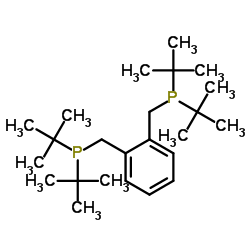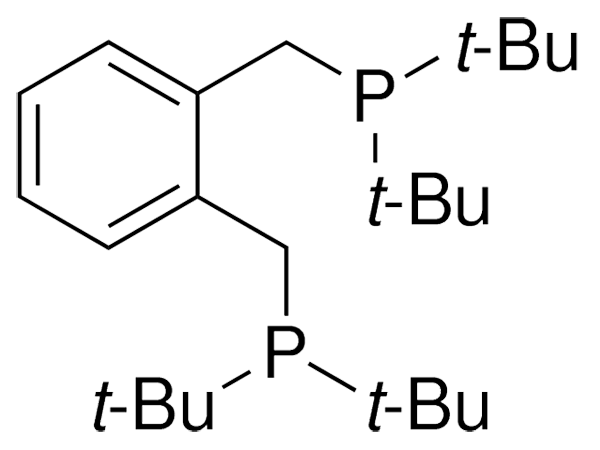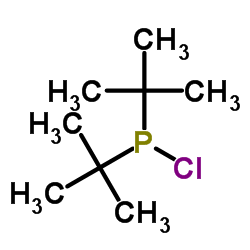1,2-双(二叔丁基膦甲基)苯 ,1,2-Bis(di-tert-butylphosphinomethyl)benzene
产品编号:SIGMA-631922| CAS NO:121954-50-5| 分子式:C24H44P2| 分子量:394.5537
本网站销售的所有产品仅用于工业应用或者科学研究等非医疗目的,不可用于人类或动物的临床诊断或者治疗,非药用,非食用,
| 产品名称 | 1,2-双(二叔丁基膦甲基)苯 |
|---|---|
| 英文名称 | 1,2-Bis(di-tert-butylphosphinomethyl)benzene |
| CAS编号 | 121954-50-5 |
| 产品熔点 | 59-62ºC |
| 产品沸点 | 456.7±38.0 °C at 760 mmHg |
| 产品闪点 | 243.6±33.1 °C |
| 精确质量 | 394.291809 |
| PSA | 27.18000 |
| LogP | 8.05 |
| 外观性状 | crystal | white |
| 蒸气压 | 0.0±1.1 mmHg at 25°C |
| 稳定性 | 如果遵照规格使用和储存则不会分解,未有已知危险反应 |
| 储存条件 | 保持贮藏器密封、储存在阴凉、干燥的地方,确保工作间有良好的通风或排气装置 |
相关文档
化学品安全说明书(MSDS)
下载MSDS质检证书(COA)
相关产品
| 个人防护装备 | Eyeshields;Gloves;type N95 (US);type P1 (EN143) respirator filter |
|---|---|
| 风险声明 (欧洲) | R36/37/38 |
| 安全声明 (欧洲) | S26 |
| 危险品运输编码 | NONH for all modes of transport |
| WGK德国 | 3 |
|
Section 1: Product Identification Chemical Name:alpha,alpha'-Bis(di-t-butylphosphino)-o-xylene, min. 97% CAS Registry Number:121954-50-5 Formula:C6H4[CH2P(C4H9)2]2 EINECS Number:none Chemical Family:organophosphine ligand Synonym:1,2-Bis(di-t-butylphosphinomethyl)benzene
Section 2: Composition and Information on Ingredients IngredientCAS NumberPercentACGIH (TWA)OSHA (PEL) Title compound121954-50-5100%no datano data Section 3: Hazards Identification Emergency Overview:Irritating to skin, eyes and respiratory tract. May be harmful if swallowed. Primary Routes of Exposure:Ingestion, inhalation Eye Contact:Causes slight to mild irritation of the eyes Skin Contact:Causes slight to mild irritation of the skin. Inhalation:Irritating to the nose, mucous membranes and respiratory tract. Ingestion:No specific information is available on the physiological effects of ingestion. May be harmful if swallowed. Acute Health Affects:Irritating to skin, eyes and respiratory tract. Chronic Health Affects:No information available on the effects of long-term exposure. NTP:No IARC:No OSHA:No SECTION 4: First Aid Measures Immediately flush the eyes with copious amounts of water for at least 10-15 minutes. A victim may need Eye Exposure: assistance in keeping their eye lids open. Get immediate medical attention. Wash the affected area with water. Remove contaminated clothes if necessary. Seek medical assistance if Skin Exposure: irritation persists. Remove the victim to fresh air. Closely monitor the victim for signs of respiratory problems, such as difficulty Inhalation: in breathing, coughing, wheezing, or pain. In such cases seek immediate medical assistance. Seek medical attention immediately. Keep the victim calm. Give the victim water (only if conscious). Induce Ingestion: vomiting only if directed by medical personnel. SECTION 5: Fire Fighting Measures Flash Point:no data Autoignition Temperature:none Explosion Limits:none Extinguishing Medium:carbon dioxide, dry powder or foam If this material is involved in a fire, fire fighters should be equipped with a NIOSH approved positive pressure Special Fire Fighting Procedures: self-contained breathing apparatus and full protective clothing. Hazardous Combustion andIf involved in a fire this material may emit toxic organic fumes. Decomposion Products: Unusual Fire or Explosion Hazards: Flammable solid. No unusual fire or explosion hazards. SECTION 6: Accidental Release Measures Spill and Leak Procedures:Small spills can be mixed with vermiculite or sodium carbonate and swept up. SECTION 7: Handling and Storage Handling and Storage:Material will degrade on exposure to air. Handle and store under an inert atmosphere of nitrogen or argon. SECTION 8: Exposure Controls and Personal Protection Eye Protection:Always wear approved safety glasses when handling a chemical substance in the laboratory. Skin Protection:Wear protective clothing and gloves. Ventilation:Material may form a fine dust. If possible, handle the material in an efficient fume hood. If ventilation is not available a respirator should be worn. The use of respirators requires a Respirator Respirator: Protection Program to be in compliance with 29 CFR 1910.134. Ventilation:Material may form a fine dust. If possible, handle the material in an efficient fume hood. Additional Protection:No additional protection required. SECTION 9: Physical and Chemical Properties Color and Form:white xtl. Molecular Weight:394.56 Melting Point:59-62° Boiling Point:no data Vapor Pressure:no data Specific Gravity:no data Odor:no data Solubility in Water:no data SECTION 10: Stability and Reactivity Stability:air-sensitive solid Hazardous Polymerization:none Conditions to Avoid:none Incompatibility:oxidizing agents, halogens Decomposition Products:carbon dioxide, carbon monoxide, organic fumes, and phosphorus oxides. SECTION 11: Toxicological Information RTECS Data:No information available in the RTECS files. Carcinogenic Effects:No data available Mutagenic Effects:No data available Tetratogenic Effects:No data available SECTION 12: Ecological Information Ecological Information:No information available SECTION 13: Disposal Considerations Disposal:Dispose of according to local, state and federal regulations. SECTION 14: Transportation Shipping Name (CFR):Non-hazardous Hazard Class (CFR):NA Additional Hazard Class (CFR):NA Packaging Group (CFR):NA UN ID Number (CFR):NA Shipping Name (IATA):Non-hazardous Hazard Class (IATA):NA Additional Hazard Class (IATA):NA Packaging Group (IATA):NA UN ID Number (IATA):NA SECTION 15: Regulatory Information TSCA:Not listed in the TSCA inventory. SARA (Title 313):Not reportable under SARA Title 313 Second Ingredient:none SECTION 16 - ADDITIONAL INFORMATION N/A |
|
~55% 
121954-50-5 |
| 文献:Ineos Acrylics UK Limited Patent: US6335471 B1, 2002 ; Location in patent: Page column 4 ; |
|
~22% 
121954-50-5 |
| 文献:Ineos Acrylics UK Limited Patent: US6335471 B1, 2002 ; Location in patent: Page column 5 ; |











 浙公网安备 33010802013016号
浙公网安备 33010802013016号